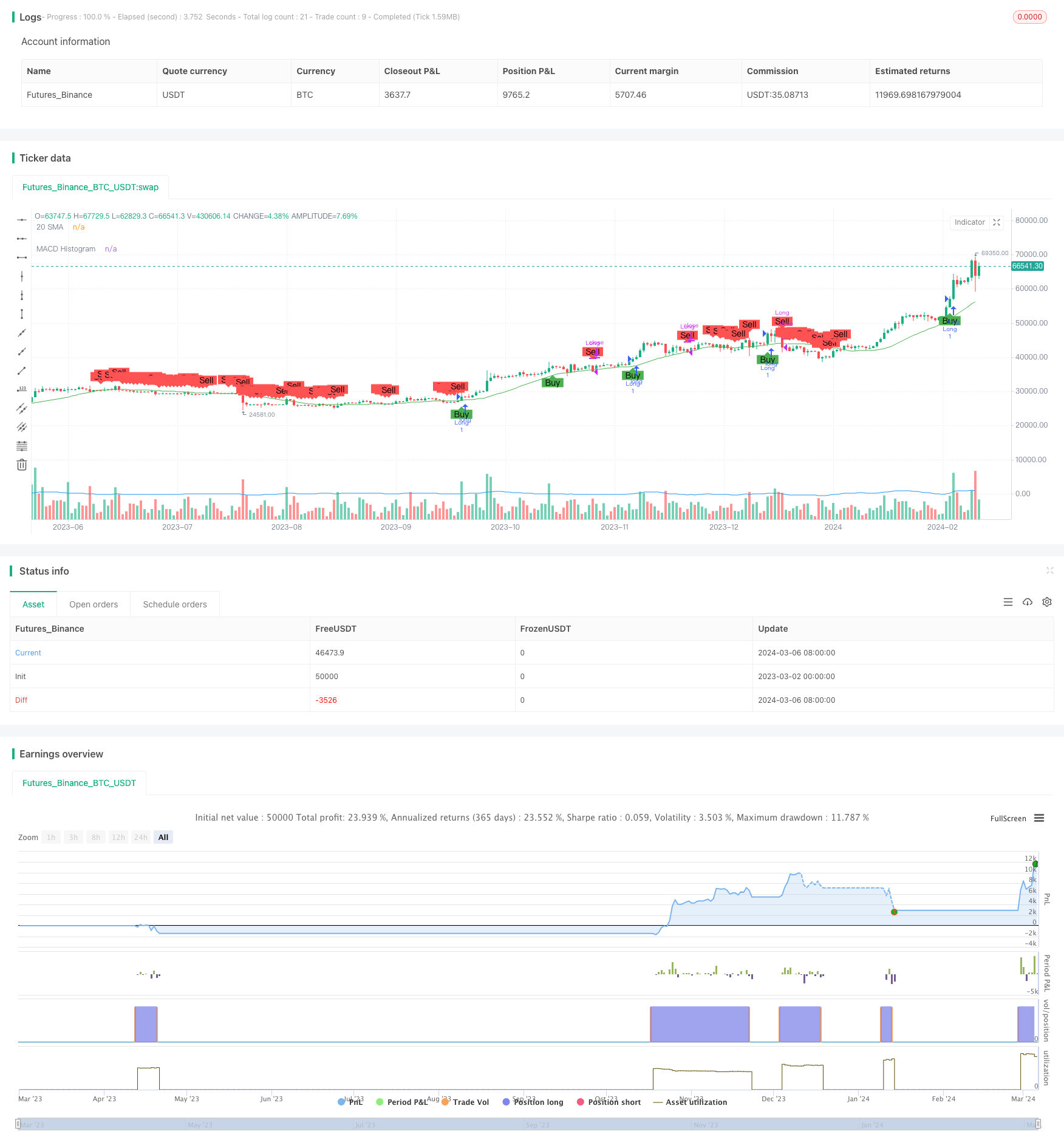
概述
MACD均线多头量化交易策略是一种基于MACD指标和20日移动平均线的量化交易策略。该策略通过判断MACD指标的短期线和长期线的交叉关系,以及股价相对于20日移动平均线的位置,来确定买入和卖出信号。当MACD短期线上穿长期线且位于0轴上方,同时股价收盘价高于20日移动平均线时,产生买入信号;当股价收盘价跌破20日移动平均线时,产生卖出信号。
策略原理
MACD均线多头量化交易策略的原理如下:
- 计算MACD指标:通过设置MACD的三个参数(短期周期、长期周期和信号周期),计算MACD的快线(MACD线)和慢线(信号线)。
- 计算20日移动平均线:通过设置20日移动平均线的周期,计算股价的20日移动平均值。
- 判断买入条件:当MACD快线上穿MACD慢线,且快线位于0轴上方,同时股价收盘价高于20日移动平均线时,产生买入信号。
- 判断卖出条件:当股价收盘价跌破20日移动平均线时,产生卖出信号。
- 记录入场价格:当买入条件满足时,记录当前股价作为入场价格。
- 执行交易:根据买入和卖出信号,执行相应的交易操作,买入或卖出股票。
该策略利用了MACD指标和移动平均线两个技术指标,通过它们的结合来判断市场趋势和交易时机。MACD指标用于捕捉市场的动量变化,而移动平均线用于确认价格趋势。当两个指标都发出同向信号时,认为趋势较为确定,进而产生交易信号。
优势分析
MACD均线多头量化交易策略具有以下优势:
- 趋势跟踪:该策略通过MACD指标和移动平均线来判断市场趋势,能够有效地跟踪市场的主要趋势,避免在震荡市中频繁交易。
- 信号确认:策略同时使用了MACD指标和移动平均线两个技术指标,通过它们的共同确认来提高交易信号的可靠性,减少假信号。
- 简单易用:该策略规则简单明了,易于理解和实现,适合不同层次的交易者使用。
- 参数灵活:策略中的MACD参数和移动平均线周期可以根据不同的市场环境和交易品种进行调整,以优化策略表现。
风险分析
尽管MACD均线多头量化交易策略有其优势,但仍然存在一些风险:
- 趋势识别滞后:MACD指标和移动平均线都是滞后指标,它们对市场趋势的识别存在一定的延迟。在市场快速变化时,策略可能会出现滞后现象,导致错过最佳交易时机或产生错误信号。
- 震荡市中效果欠佳:该策略在震荡市中可能会出现频繁的交易信号,导致交易次数增加和利润减少。策略在趋势市中表现较好,但在震荡市中可能会面临更多的挑战。
- 参数设置敏感:策略的表现在一定程度上依赖于MACD参数和移动平均线周期的选择。不恰当的参数设置可能导致策略表现不佳。
为了应对这些风险,可以考虑以下解决方法:
- 结合其他指标:在策略中加入其他技术指标,如RSI、布林带等,以辅助判断市场趋势和交易时机,提高策略的适应性。
- 优化参数:通过对历史数据进行回测和参数优化,找到适合不同市场环境和交易品种的最优参数组合,提高策略的稳健性。
- 设置止损:在策略中加入止损机制,当交易出现一定的亏损时及时平仓,以控制风险和减少单次交易的最大损失。
优化方向
为了进一步提升MACD均线多头量化交易策略的性能,可以考虑以下优化方向:
- 动态参数优化:根据市场状况的变化,实时调整策略参数,如MACD的周期参数和移动平均线周期。可以使用自适应算法或机器学习方法来实现参数的动态优化,以适应不同的市场环境。
- 加入风险管理:在策略中引入风险管理模块,如仓位管理、资金管理等,根据市场波动性和账户风险情况动态调整仓位大小,控制整体风险敞口。
- 多空双向交易:目前该策略只考虑了多头交易,可以扩展为多空双向交易,在判断市场趋势向下时进行卖空操作,以捕捉更多的交易机会。
- 多时间周期分析:在策略中引入多时间周期分析,如同时考虑日线、小时线等不同时间周期的MACD指标和移动平均线,通过多个时间周期的确认来提高交易信号的可靠性。
- 组合其他策略:将MACD均线多头策略与其他量化交易策略进行组合,如趋势跟踪策略、均值回归策略等,通过策略组合来提高整体收益和稳定性。
这些优化方向可以帮助改进策略的适应性、风险管理能力和收益潜力,使策略在不同市场环境下都能有更好的表现。通过不断的优化和改进,可以使MACD均线多头量化交易策略更加稳健和有效。
总结
MACD均线多头量化交易策略是一种结合MACD指标和移动平均线的趋势跟踪策略。它通过判断MACD指标的快慢线交叉关系和股价相对于移动平均线的位置,产生买入和卖出信号。该策略的优势在于趋势跟踪、信号确认、简单易用和参数灵活。但同时也存在趋势识别滞后、震荡市中效果欠佳和参数设置敏感等风险。为了改进策略,可以考虑结合其他指标、优化参数和设置止损等方法。此外,还可以通过动态参数优化、加入风险管理、多空双向交易、多时间周期分析和组合其他策略等方向来进一步优化策略。总的来说,MACD均线多头量化交易策略为投资者提供了一种简单有效的交易工具,通过不断优化和改进,可以提高策略的适应性和稳健性,帮助投资者在不同市场环境下获得更好的交易结果。
/*backtest
start: 2023-03-02 00:00:00
end: 2024-03-07 00:00:00
period: 1d
basePeriod: 1h
exchanges: [{"eid":"Futures_Binance","currency":"BTC_USDT"}]
*/
//@version=5
strategy("MACD Long Strategy", overlay=true)
// MACD设置
macdLengthShort = input(12, title="MACD Short Length")
macdLengthLong = input(26, title="MACD Long Length")
macdLengthSignal = input(9, title="MACD Signal Length")
// 20均线
smaLength = input(20, title="20 SMA Length")
// 计算MACD
[macdLine, signalLine, _] = ta.macd(close, macdLengthShort, macdLengthLong, macdLengthSignal)
// 计算20均线
smaValue = ta.sma(close, smaLength)
// 入场条件
enterLong = ta.crossover(macdLine, signalLine) and macdLine > 0 and close > smaValue
// 出场条件
exitLong = close < smaValue
// 记录入场价
var float entryPrice = na
if (enterLong)
entryPrice := close
// 下单逻辑
strategy.entry("Long", strategy.long, when=enterLong)
strategy.close("Long", when=exitLong)
// 画出MACD线和20均线
plot(macdLine - signalLine, title="MACD Histogram", color=color.blue)
plot(smaValue, title="20 SMA", color=color.green)
// 画出买卖信号
plotshape(enterLong, color=color.new(color.green, 0), style=shape.labelup, location=location.belowbar, size=size.small, text="Buy")
plotshape(exitLong, color=color.new(color.red, 0), style=shape.labeldown, location=location.abovebar, size=size.small, text="Sell")